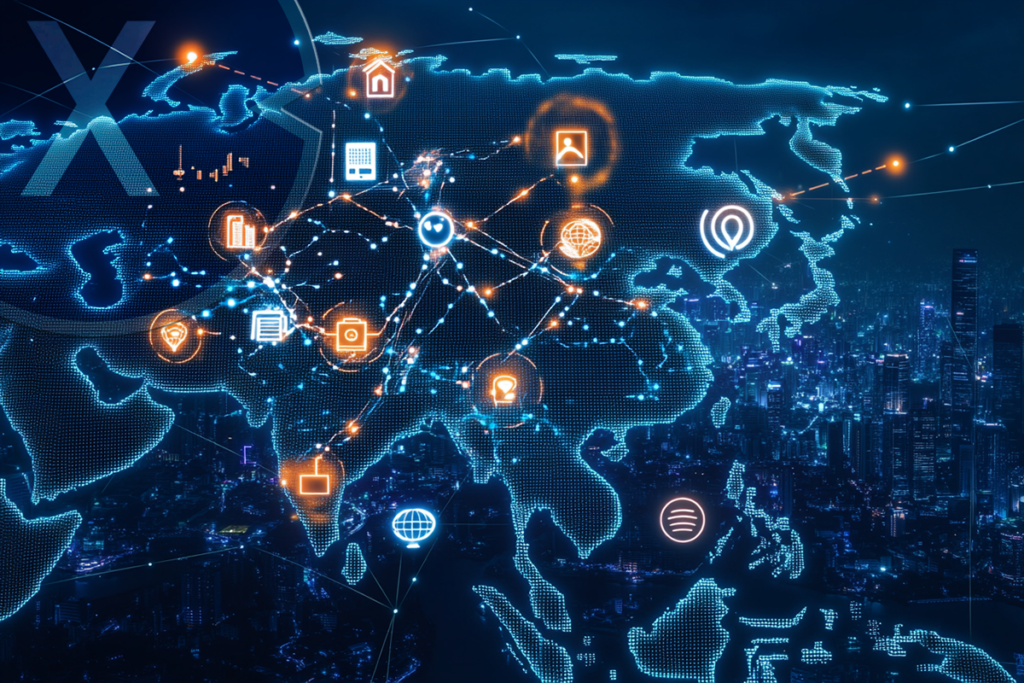Published on: November 6th, 2024 / Update from: November 6th, 2024 - Author: Konrad Wolfenstein
🔧 Europe meets Asia: IoT innovations as a bridge to market potential
New horizons: IoT as a growth engine for Europe in the Asian market
IoT innovations offer Germany and Europe a significant opportunity to tap the potential of the Asian market. Asia, particularly the Asia-Pacific region, is experiencing rapid growth in the Internet of Things (IoT) space, driven by the adoption of 5G, digital transformation and the need for connected solutions across various industries such as manufacturing, healthcare and smart cities.
Germany and Europe's strengths in the IoT sector
Germany: pioneer in industrial IoT use
Germany is a global pioneer in the use of the Industrial Internet of Things (IIoT), particularly through initiatives such as Industry 4.0. This initiative aims to modernize the manufacturing industry through the use of IoT, automation and artificial intelligence. German companies use IoT solutions to optimize production processes, minimize downtime and increase efficiency. This gives Germany a strong position in the global IIoT market.
Europe: A growing IoT market
Europe has the second largest market share in the global IoT market and is experiencing steady growth. The demand for IoT solutions is increasing, particularly in countries such as Germany, France and the Nordic countries. The European market is driven by increasing digitalization in areas such as healthcare, energy and smart cities. Increasing urbanization and the use of cloud-based IoT platforms are also contributing to growth.
The potential of the Asian market
Asia Pacific: The fastest growing IoT market
Asia Pacific is the fastest growing region in the global IoT market. The market is expected to grow at a compound annual growth rate (CAGR) of 30.1% through 2030. This growth is being driven by the introduction of 5G networks, the increased use of cloud technologies and government-funded smart city projects in countries such as China, India and Japan. China in particular is investing heavily in IIoT solutions for its manufacturing industry and smart city initiatives.
Growth opportunities through 5G and digital transformation
The rollout of 5G networks in Asia enables faster data processing and lower latency, significantly boosting the adoption of IoT devices. These networks support advanced applications such as autonomous vehicles and automated production systems. Additionally, digital transformation initiatives in countries such as India and South Korea are driving demand for connected devices.
Strategic opportunities for Germany and Europe
1. Exporting Industrial IoT Solutions
German companies have the opportunity to export their expertise in the field of IIoT to Asia. The growing demand for automation solutions in the Asian manufacturing industry offers German providers of IIoT solutions an attractive expansion opportunity.
2. Cooperations with Asian companies
European companies can strengthen their market presence through strategic partnerships with Asian companies. Such collaborations could focus on areas such as smart cities, healthcare or logistics, where European innovations could meet Asian market needs.
3. Using 5G for new applications
With the spread of 5G in Asia, German and European companies can develop new IoT applications that rely on real-time data processing. This could be particularly relevant in the area of autonomous vehicles or intelligent energy supply systems.
challenges
Although the potential is great, there are also challenges:
Safety concerns
Increasing connectivity poses risks of cyberattacks, which is seen as an obstacle to the growth of the IoT market, particularly in the Asia-Pacific region.
Cultural differences
European companies must adapt to local market conditions and take cultural differences into account in order to be successful.
Potential for Germany and Europe
Thanks to their leading role in the area of industrial IoT solutions, Germany and Europe are in an excellent starting position to tap the immense potential of the Asian market. Through strategic partnerships, the export of technological innovations and the use of 5G networks, they can expand their presence in Asia and benefit from the rapid development of this dynamic market.
Suitable for:
- Smart Factory and Industry X.0 digitalization – Image: Xpert.Digital
- Innovation in logistics: Using the possibilities of the Internet of Things to increase efficiency and security in warehouse infrastructures - Image: Xpert.Digital
- Sensor technology in cities and the economy: Sensors for IoT & Industry 4.0 | Industrial & City Metaverse – Image: Xpert.Digital
- The enormous opportunities for German companies with IoT on the Asian market: potential and strategies for conquering the market - Image: Xpert.Digital
- IoT, AI, industry and mechanical engineering: The vision of Industry 4.0, which was developed in Germany, is well received worldwide - Image: Xpert.Digital
- IoT optimization: How logistics uses the Internet of Things (IoT) to improve warehouse processes - Image: Xpert.Digital
🔍 The Asian IoT market
🔧 The Asian market offers German and European companies enormous opportunities in the area of the Internet of Things (IoT). Rapid economic growth, increasing purchasing power and increasing digitalization in countries such as China, India, Japan and South Korea create fertile ground for innovative IoT solutions. European companies can take a leading role in this dynamic market with their technological know-how and experience in Industry 4.0. However, in order to be successful, the specific challenges of the Asian market must be mastered.
💬 Adaptation to local needs
A crucial factor for the success of European IoT providers in Asia is adapting to local needs. The requirements for IoT solutions vary depending on the country and industry. While the focus in China is on smart cities and industrial automation, in India the focus is on improving agricultural productivity and access to healthcare services. European companies need to adapt their products and services to these specific needs and, where appropriate, enter into partnerships with local actors.
🗺️ Market strategy and cultural differences
The size and complexity of the Asian market require careful market strategy. A thorough market analysis, identifying the relevant target groups and selecting the right sales channels are essential. It is important to take cultural differences into account and develop a deep understanding of local business practices. Building trust and long-term relationships with customers and partners is particularly important in Asia.
🔒 Regulatory framework
Another important aspect is the consideration of the regulatory framework. Privacy regulations and security standards vary significantly across Asian countries. European companies need to ensure that their IoT solutions comply with local regulations and ensure data security. This requires close cooperation with local authorities and experts.
🏆 Competition and added value
Competition in the Asian IoT market is intense. In addition to established international corporations, numerous local companies are also entering the market. In order to stand out from the competition, European providers must offer clear added value. This can be achieved through innovative technologies, high quality standards, customer-specific solutions or attractive pricing models.
🏙️ Smart city development
A promising field of application for IoT solutions in Asia is smart city development. Rapid urbanization in many Asian countries is leading to challenges in the areas of transport, energy supply, the environment and security. IoT technologies can help overcome these challenges and improve the quality of life in cities. Examples of this include intelligent traffic control systems, energy-efficient building automation and environmentally friendly waste disposal.
🏭 IoT in the industrial sector
The IoT also offers enormous potential in the industrial sector. The increasing automation and digitalization of production processes is creating high demand for IoT solutions. With their know-how in the area of Industry 4.0, European companies can make an important contribution to the modernization of Asian industry. Examples of applications include predictive maintenance of machines, optimizing supply chains and increasing production efficiency.
🩺 IoT in healthcare
In healthcare, IoT solutions can help improve medical care in Asia. The growing population and the shortage of qualified medical personnel require innovative solutions. Examples of this include remote patient monitoring, digital management of patient data and the development of new diagnostic and treatment methods.
🌾 IoT in agriculture
Agriculture is another important sector where IoT technologies can make a big contribution. The increasing demand for food and the challenges of climate change require more efficient and sustainable agriculture. IoT solutions can help optimize water consumption, reduce fertilizer use and increase crop yields.
🚀 Europe's opportunities in Asia's IoT market
The Asian market offers great opportunities for European IoT providers. In order to successfully exploit these opportunities, companies must adapt their strategies to local needs, take the regulatory framework into account and offer clear added value. With their technological know-how and experience, European companies can take a leading role in the Asian IoT market and contribute to economic and social progress in the region. It is crucial to build long-term partnerships with local players and to develop a deep understanding of the cultural characteristics of the Asian market. The challenges are great, but the potential is even greater.
Suitable for:








